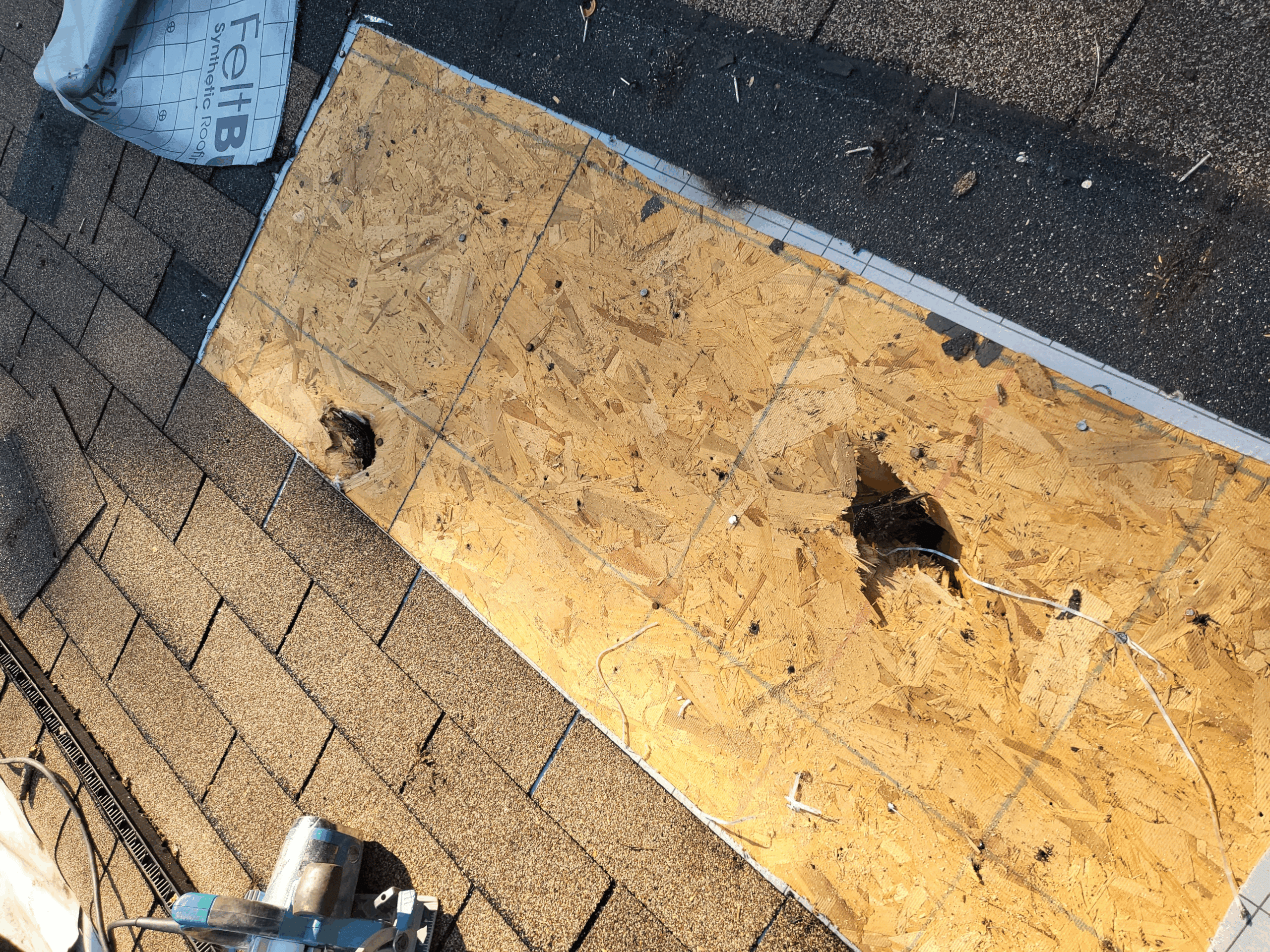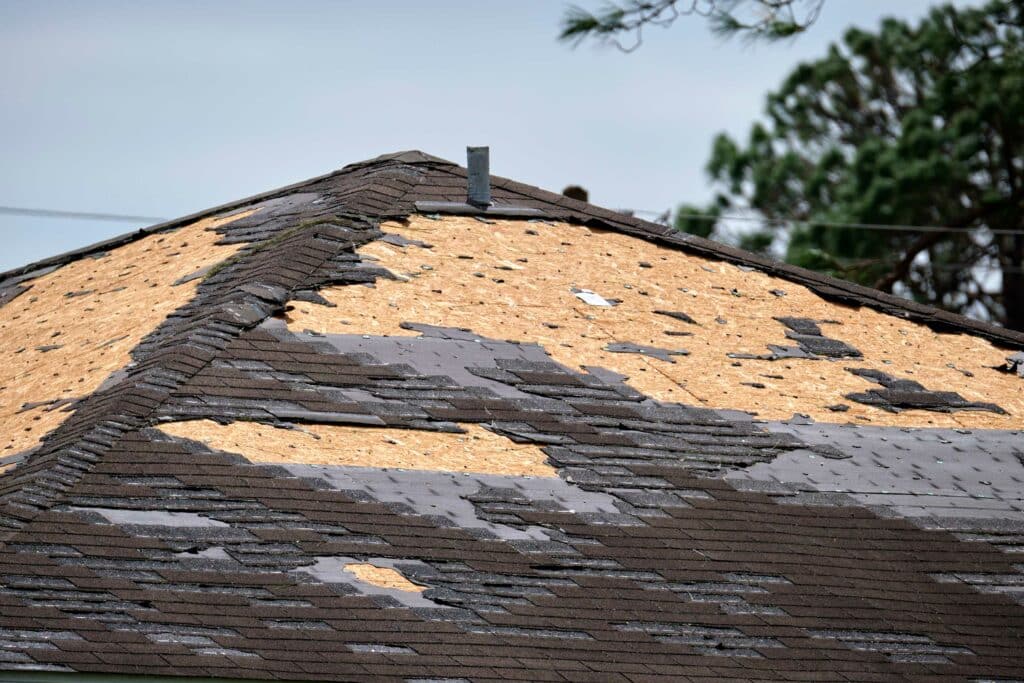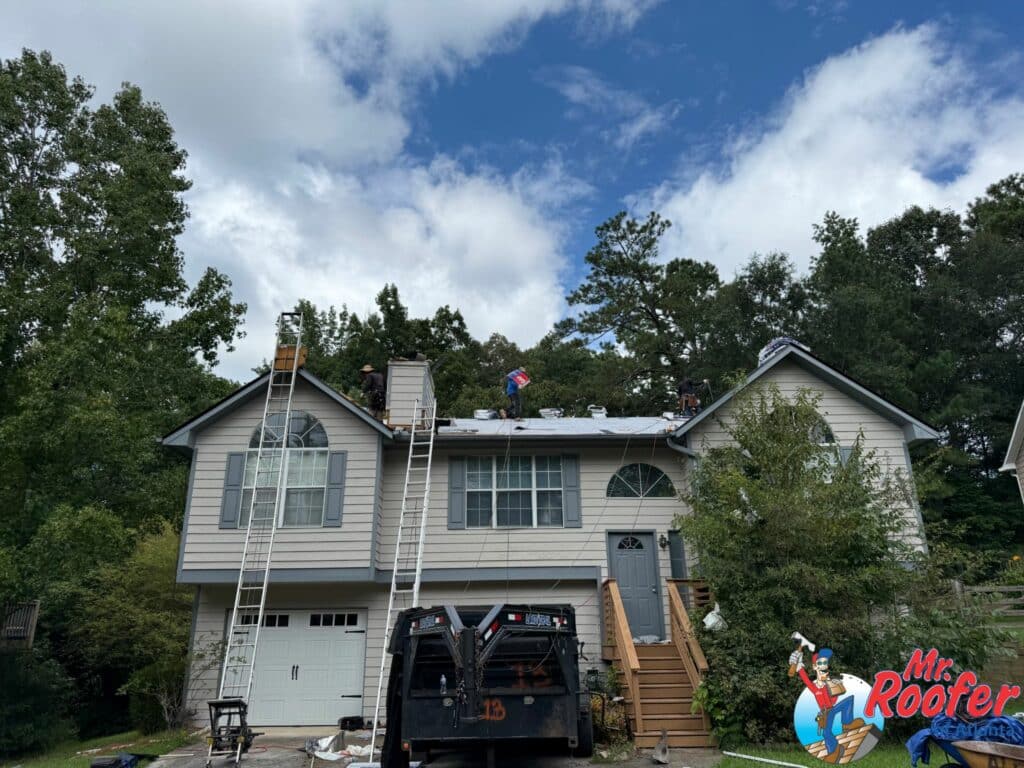
You wake up to the sound of rain tapping unevenly against your ceiling, and that small water stain you noticed last week has grown overnight. A leak in your roof isn’t just a nuisance—it’s a warning sign that hidden damage could be compromising your home’s safety, insulation, and value. The thought of costly roof damage repairs or a full replacement can feel overwhelming.
That’s where Mr. Roofer comes in. Serving homeowners across Atlanta, Marietta, Alpharetta, and nearby areas, we specialize in finding the root of roof problems and fixing them the right way. Whether it’s storm-damaged roof shingles, hidden leaks, or aging materials, our “repair-first” approach ensures you don’t pay for a replacement you don’t need.
With skilled inspections, high-quality materials, and precise repairs, we protect what matters most: your home, your comfort, and your peace of mind. When you work with Mr. Roofer, minor issues are stopped before they escalate, and your roof can continue shielding your family for years to come.
7 Common Signs of Roof Damage Homeowners Should Never Ignore

Your roof protects your home from rain, wind, sun, and storms, yet damage isn’t always immediately obvious. Many issues start small but can quickly escalate into costly roof damage repairs or structural problems if left unaddressed. Recognizing the early warning signs allows you to act before minor damage becomes a major headache. Here are seven critical signs of roof damage every homeowner should monitor.
1. Water Stains or Leaks Indoors
Water stains, bubbling or peeling paint, and musty odors often indicate hidden roof leaks. Water rarely travels straight down; it can run along beams, insulation, or walls before becoming visible. This means a stain in the corner of your ceiling could originate from a distant roof penetration, such as a damaged roof flashing or cracked shingle. Beyond cosmetic damage, prolonged exposure to moisture can:
- Rot wood
- Weaken structural supports
- Create ideal conditions for mold and mildew
This can affect indoor air quality and your family’s health. Early detection through regular inspections or moisture monitoring can prevent these cascading issues.
2. Missing, Curling, or Cracked Shingles
Shingles serve as the first line of defense against water and UV damage. Windstorms, hail, heavy rain, or even gradual aging can cause shingles to curl, crack, or lift. Missing shingles expose the underlayment and decking, accelerating deterioration and increasing the risk of leaks. Improper installation can also make shingles more vulnerable over time. Homeowners should pay attention to shingles that have lost granules, show splits, or appear brittle. Timely roof damage repair or replacement of compromised shingles protects your roof’s core layers and maintains its structural integrity.
3. Sagging or Uneven Roof Lines
Sagging, dips, or uneven roof lines often indicate serious underlying problems. Moisture trapped under the roof can weaken decking and rafters, while older wood may start to warp or rot. In some cases, sagging is caused by improper structural support or deteriorated trusses. Left unchecked, this can lead to partial collapse, interior water damage, and costly emergency repairs. A professional inspection can determine whether the issue requires reinforcement, decking replacement, or more extensive structural intervention.
4. Granules in Gutters
Asphalt shingles are coated with granules that protect against UV rays and extend the roof’s lifespan. When granules start accumulating in gutters, it’s a sign the shingles are wearing down and losing their protective layer. This not only shortens the roof’s life but also leaves it more susceptible to:
- Sun damage
- Cracking
- Water infiltration
In Atlanta’s hot summers, UV exposure can rapidly accelerate granule loss. Homeowners should monitor gutters, valleys, and downspouts for granule buildup and schedule maintenance or shingle replacement as needed.
5. Rusted or Damaged Flashing
Flashing is the metal barrier installed around roof joints, chimneys, valleys, skylights, and vents to prevent water intrusion. Over time, flashing can rust, crack, or lift due to weather exposure or improper installation. Damaged roof flashing is one of the most common causes of leaks, as water can penetrate unnoticed, damaging underlayment and framing. Regular inspection and timely roof damage repair or replacement of flashing are critical to maintaining a watertight roof system, especially in areas prone to heavy rainfall or strong winds.
6. Mold, Moss, or Black Streaks
The appearance of moss, algae, or black streaks on shingles signals prolonged moisture retention. Moss can lift shingles, allowing water to seep underneath, while algae and mold thrive in damp, shaded areas or where ventilation is poor. Persistent moisture not only reduces the effectiveness of your shingles but can also accelerate rot and compromise roof decking. Homeowners should apply the following tips to prevent these growths from spreading:
- Ensure proper attic ventilation
- Remove vegetation overhanging the roof
- Address leaks immediately
7. Sudden Spikes in Energy Bills
A roof is more than a barrier against water; it also helps insulate your home. Damage to shingles, underlayment, or ventilation systems can break the thermal envelope, letting conditioned air escape and forcing your HVAC system to work harder. Unexplained increases in heating or cooling costs may indicate hidden roof damage or insulation gaps. By addressing roof issues early, homeowners can preserve energy efficiency, maintain comfort, and avoid unnecessary strain on heating and cooling equipment.
Types of Roof Damage and What Causes Them

Roofs face a variety of challenges over their lifetime, from severe weather to everyday wear and tear. Understanding the different types of roof damage and their common causes can help homeowners take preventative measures and address problems before they escalate.
Type of Roof Damage | Causes & Details | Key Notes for Homeowners |
Storm & Wind Damage | Strong winds can lift or displace shingles, tear off flashing, and drive debris against the roof. | Georgia storms and tornado-grade gusts frequently cause these issues. Prompt inspection after severe weather is essential. |
Hail Damage | Hailstones can leave circular dents, fractures, or punctures in shingles. | Even minor damage weakens waterproofing layers. Professional assessment may be needed for roof damage repair or replacement. |
Water Damage & Leaks | Poor drainage, missing or damaged roof shingles, or cracked pipe boots. Water can travel along plywood sheathing before dripping inside. | Early detection prevents mold, wood rot, and interior damage. |
UV & Heat Damage | Prolonged sunlight dries out shingles, causing cracking, curling, and granule loss. | Atlanta’s hot summers accelerate aging, reducing roof protection. |
Structural Damage | Sagging rafters or soft decking from long-term moisture infiltration. | Can compromise stability and require costly repairs if ignored. |
Pest & Animal Damage | Squirrels, birds, or other animals nesting under loose shingles or gnawing on soffits and fascia. | Creates entry points for water and pests. Regular inspections help prevent infestations. |
Age-Related Wear | Natural deterioration of roofing materials over time. Typical lifespans: asphalt = 20 years, cedar = 30 years, composite = 50 years. | Understanding expected lifespan helps plan maintenance and replacement. |
How Roof Damage Happens: The Underlying Causes
Roof damage often results from a combination of environmental stress, material issues, and lack of upkeep. Understanding the underlying causes can help homeowners prevent problems and address them quickly before they escalate.
Weather Exposure and Seasonal Changes
Freeze-thaw cycles cause roofing components to expand and contract, which can lead to popped nails, cracked seals, and small gaps where water can enter. Heavy rain, hail, and intense sun further accelerate wear and reduce the roof’s lifespan.
Poor Installation or Cheap Materials
Low-quality underlayment, improperly installed flashing, or inferior shingles leave a roof vulnerable to leaks and premature deterioration. Mr. Roofer always uses certified GAF materials and follows proper installation methods to ensure long-lasting protection.
Neglected Maintenance
Clogged gutters, debris accumulation, and unsealed flashing allow water to pool and accelerate decay. Regular maintenance, including cleaning gutters and inspecting shingles and flashing, is critical for preventing minor issues from becoming major repairs.
Ventilation or Insulation Problems
Inadequate attic ventilation or insulation traps moisture, leading to rotting sheathing, weakened rafters, and mold growth. Proper airflow and insulation are essential to keep the roof and underlying structure healthy.
Hidden Issues Around Roof Penetrations
Frequent sources of leaks if seals deteriorate include areas around:
- Pipe boots
- Chimneys
- Skylights
- Vents
Even small cracks or gaps in these penetrations can let water in, causing damage that may go unnoticed until it spreads.
Damage Roof Repair vs. Roof Replacement: Which Is Right for You?
Not all roof problems require a full replacement. Understanding when a roof damage repair is sufficient versus when a replacement is necessary helps homeowners make informed decisions and protect their investment.
When a Roof Repair Makes Sense
Roof damage repairs are ideal for localized issues such as missing shingles, minor flashing leaks, or small storm damage. Mr. Roofer follows a repair-first philosophy, providing honest assessments and only recommending replacement when absolutely necessary. This approach saves money and extends the roof’s lifespan without sacrificing protection.
When a Roof Replacement Is Necessary
A full roof replacement is usually required when there is widespread shingle failure, severe decking rot, or multiple leaks across different areas. Replacement ensures structural integrity, prevents recurring problems, and is often the safest long-term solution for heavily damaged roofs.
Cost Comparison Table
Type | Average Cost Range | When It’s Appropriate |
Roof Repair | $300 – $1,500 | Minor leaks, missing shingles, small storm damage |
Roof Replacement | $5,000 – $15,000+ | Widespread shingle failure, decking damage, multiple leaks |
For detailed cost breakdowns by roof type, see Mr. Roofer’s Roof Repair Cost Guide
Benefits of Choosing Repair First
Opting for roof damage repair before replacement can:
- Extend your roof’s life by 5-10 years
- Avoid unnecessary costs
- Maintain curb appeal
Mr. Roofer’s team specializes in advanced leak detection and precision repair, addressing problems effectively while preserving as much of your existing roof as possible.
How to Tell If You Have a Broken Roof: Quick At-Home Checklist
Homeowners don’t always need to climb onto the roof to identify potential problems. Regular visual inspections and simple checks around your home can reveal signs of damage early, helping you call in professionals before minor issues become major roof damage repairs.
Area to Check | What to Look For | What It Means |
Shingles | Missing, cracked, curling, or granule loss | Exposed underlayment, reduced waterproofing, increased risk of leaks |
Flashing & Roof Penetrations | Rust, lifted edges, or deteriorated seals around chimneys, vents, and skylights | Water can enter at vulnerable joints, leading to leaks and structural damage |
Gutters & Downspouts | Accumulation of shingle granules, standing water, or debris | Granule loss signals aging shingles; standing water may indicate poor drainage or leaks |
Attic | Water stains, damp insulation, mold, or musty odors | Hidden leaks or condensation issues that can weaken rafters and promote mold growth |
Roof Deck / Eaves | Sagging, soft spots, or uneven lines visible from the ground | Structural weakness from prolonged moisture exposure or decking deterioration |
Ventilation & Insulation | Signs of trapped moisture, heat damage, or insufficient airflow | Can cause accelerated shingle deterioration and interior condensation problems |
Exterior Walls & Ceilings | Peeling paint, water stains, or bubbling near roofline | Indicates water intrusion from roof leaks or failing flashing |
This checklist allows you to monitor your roof’s condition safely and efficiently. If any of these warning signs appear, scheduling a professional inspection with a trusted expert like Mr. Roofer is the safest next step.
Preventing Future Roof Damages

Regular maintenance and proactive care are the best ways to extend your roof’s life and avoid costly repairs. Small, consistent actions can protect your home from leaks, structural damage, and premature aging.
Annual Roof Inspections
Scheduling yearly inspections helps catch small issues early, especially after severe weather. Professional assessments can identify:
- Loose shingles
- Damaged roof flashing
- Other problems before they escalate
Clean Gutters and Downspouts
Keeping gutters and downspouts clear prevents water from backing up, which can lead to fascia and soffit rot. Regular cleaning ensures proper drainage and protects both your roof and your home’s exterior.
Trim Overhanging Branches
Branches that hang over your roof can cause impact damage during storms and lead to leaf buildup, which traps moisture and accelerates shingle deterioration. Regular trimming minimizes these risks.
Check Attic Ventilation
Proper attic ventilation maintains airflow and prevents condensation and mold growth. Ensuring vents are unobstructed helps preserve roof decking and shingles while improving energy efficiency.
Invest in Quality Materials
High-quality roofing materials such as synthetic or composite shingles offer longer lifespans and better resistance to weather, UV exposure, and moisture. Choosing durable materials reduces maintenance needs and protects your investment over time.
Conclusion
A well-maintained roof is essential for protecting your home, your family, and your investment. From spotting early signs of damage to understanding the underlying causes and knowing when to repair or replace, staying proactive can save you time, money, and stress. Mr. Roofer’s repair-first philosophy ensures that every problem is addressed the right way, using high-quality materials and expert craftsmanship to extend the life of your roof.
Don’t wait until a small leak becomes a major issue. Contact Mr. Roofer today for a professional inspection, expert advice, and reliable roof damage repairs that keep your home safe and secure.
